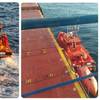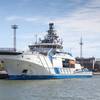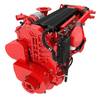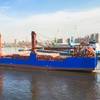MF Vardehorn, a Norwegian car and passenger ferry, was having problems with one of its four propulsion engines. The contract to replace the engine was awarded to Marhaug A/S, Volvo Penta’s dealer in Svolvaer, Norway. The replacement, which involved cutting holes in the ship’s hull to install the new engine, was completed between two scheduled runs by the ferry.
“We are extremely satisfied with the engine replacement and the manner in which Volvo Penta helped us solve our problem. The work was completed quickly, without requiring us to take the ferry out of traffic,” says shipping company inspector Jan Sletteng of TFDS, owner of the MF Vardehorn.
Volvo Penta has been expanding its product program by including marine diesel engines with cylinder volumes ranging from 25 to 65 liters. The expanded engine program has enabled Volvo Penta to compete for contracts that require completely new types of installations. The MF Vardehorn is propelled by four diesel engines connected to a diesel-electric drive system. The ship’s new engine is a 460-kW Volvo Penta D30A MT. The engine replaced a similar machine supplied by another manufacturer that has experienced problems with cavitation in the engine block and excessive wear.
“The new engine was mounted on the existing frame and connected to the existing generator. However, after conducting a fault-tracking test on the old engine, we made certain changes in the installation to solve the problems with cavitation,” says Jan Marhaug of Marhaug A/S.
Night work
The MF Vardehorn operates in regularly scheduled traffic between Hareid and Sulesund in Sunnmöre. Two ferries service the line, and the engine was replaced at night without any disruptions in scheduled crossings. Careful preparations were made before the ship was brought in for its depot stop on Saturday afternoon.
“We cut a hole in the hull at 5:30 in the evening, and the engine was installed early Sunday morning. The ferry was back in operation with three engines for the morning run at 9:30 a.m., and we continued our installation onboard. All four engines were fully functional on Monday, and the ferry was completely back to normal,” says Jan Marhaug.
Subscribe for
Maritime Reporter E-News
Maritime Reporter E-News is the maritime industry's largest circulation and most authoritative ENews Service, delivered to your Email five times per week












